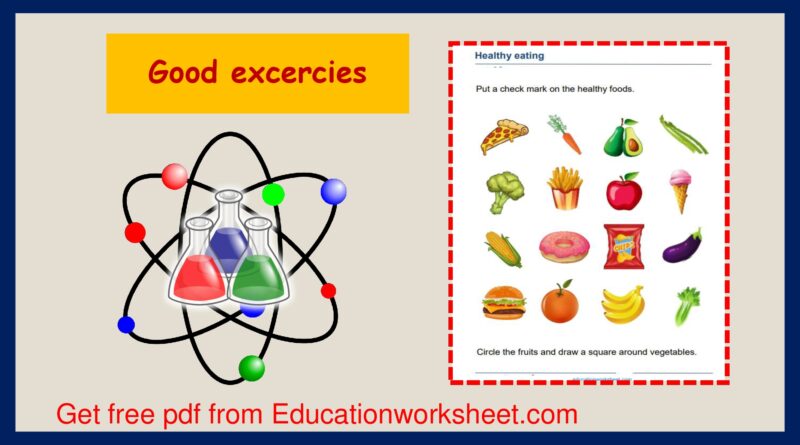healthy eating worksheets for kids.
healthy eating worksheets for kids
What is heathly food?
Healthy food refers to foods that provide essential nutrients, such as vitamins, minerals, protein, carbohydrates, and healthy fats, while also being low in added sugars, saturated fats, and excessive salt. Healthy foods contribute to overall well-being, support growth and development, and reduce the risk of chronic diseases. Here are some key characteristics of healthy foods and you can find healthy eating worksheets for kids.
1. Balanced Nutrition:
Healthy foods provide a balance of macronutrients (carbohydrates, proteins, and fats) and micronutrients (vitamins and minerals) necessary for optimal bodily functions.
2. Whole and Minimally Processed:
Healthy foods are often whole or minimally processed. They are closer to their natural state and contain fewer additives, preservatives, and artificial ingredients.
3. High in Fiber:
Many healthy foods, such as fruits, vegetables, whole grains, and legumes, are rich in dietary fiber. Fiber aids digestion, helps maintain a healthy weight, and lowers the risk of certain diseases.
4. Low in Added Sugars:
Healthy foods typically have minimal added sugars. Excessive sugar consumption can contribute to obesity, diabetes, and heart disease.
5. Low in Saturated Fats:
Healthy foods are low in saturated fats, which can raise cholesterol levels and increase the risk of heart disease.
6. Rich in Nutrients:
Healthy foods are nutrient-dense, meaning they provide a high concentration of essential vitamins and minerals per calorie.
7. Variety:
A healthy diet includes a variety of foods from different food groups to ensure a broad spectrum of nutrients.
Examples of healthy foods include:
· Fruits and vegetables: These are packed with vitamins, minerals, and antioxidants.
· Whole grains: Foods like brown rice, whole wheat bread, and oats provide fiber and essential nutrients.
· Lean proteins: Sources like poultry, fish, beans, and tofu offer protein without excessive saturated fat.
· Dairy or dairy alternatives: Low-fat or unsweetened options provide calcium and other nutrients.
· Nuts and seeds: These are rich in healthy fats, vitamins, and minerals.
· Healthy fats: Olive oil, avocados, and fatty fish contain beneficial fats like monounsaturated and omega-3 fatty acids.
It’s important to note that a healthy diet is not about deprivation but about making informed choices and maintaining balance. Healthy eating worksheets for kids.a wide variety of nutrient-rich foods in appropriate portions and staying hydrated is key to promoting health and preventing diet-related diseases. Dietary needs can vary from person to person, so it’s a good idea to consult with a healthcare provider or a registered dietitian for personalized dietary recommendations.
What is junk food?
Junk food, also known as fast food or unhealthy food, refers to food and beverages that are typically high in calories, sugars, unhealthy fats (saturated and trans fats), salt (sodium), and low in essential nutrients like vitamins, minerals, and dietary fiber. These foods are often highly processed and manufactured for convenience, making them easily accessible and often affordable. Junk food is characterized by its palatability and appeal but lacks significant nutritional value. Here are some common characteristics of junk food and can use healthy eating worksheets for kids
1. High in Empty Calories: Junk food is calorie-dense but lacks the essential nutrients needed for overall health and well-being.
2. High in Sugar: Many junk foods contain added sugars, which can contribute to weight gain, tooth decay, and other health issues.
3. High in Unhealthy Fats: Junk food often contains unhealthy saturated and trans fats, which can raise cholesterol levels and increase the risk of heart disease.
4. Low in Nutrients: These foods typically provide little to no vitamins, minerals, or dietary fiber, which are essential for good health.
5. Processed and Artificial Ingredients: Junk food is heavily processed and may contain artificial additives, preservatives, and flavor enhancers.
6. Fast Food Options: Popular examples of junk food include fast food items like hamburgers, fries, and sugary drinks, as well as snacks like chips, candy bars, and soda.
7. Convenience and Portability: Junk food is often designed for quick consumption and is readily available at restaurants, convenience stores, and vending machines.
Regular consumption of junk food has been linked to various health problems, including obesity, type 2 diabetes, high blood pressure, heart disease, and dental issues. It is generally recommended to limit the intake of junk food and focus on a balanced diet rich in fruits, vegetables, whole grains, lean proteins, and healthy fats to promote overall health and well-being.healthy eating worksheets for kids.

